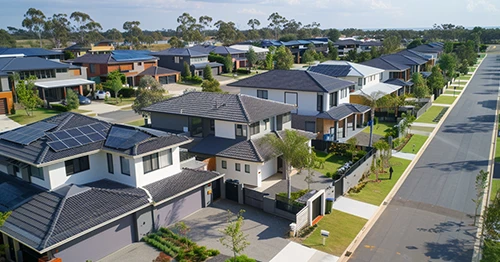Updated: 05 Feb, 2025
In January 2025, the Australian property market displayed mixed results, with national dwelling values remaining steady at -0.03%. While capital city home values dipped by 0.2%, regional Australia continued its ascent, rising by 0.4% to reach record highs. The divergence between capital cities and regional markets highlights shifting buyer preferences, affordability constraints, and ongoing economic pressures.
Read the full report.
State Performance Overview
January’s market results underscore varied performances across the states. While Brisbane and Perth continued their growth trajectories, albeit at a slower pace, Melbourne and Sydney experienced declines.
| City | HVI Change (%) | Description |
|---|---|---|
| Sydney | -0.4% | Sydney's housing values declined further, reflecting affordability challenges and increased stock levels. |
| Melbourne | -0.6% | Melbourne recorded the sharpest monthly decline, driven by affordability constraints and softening demand. |
| Brisbane | +0.3% | Despite continued growth, Brisbane’s detached housing sector is losing momentum. |
| Adelaide | +0.7% | Adelaide leads the capitals over the past six months, showing resilience despite a slowdown in gains. |
| Perth | +0.4% | Perth’s growth rate slowed from previous quarters, with a notable decline in detached house price increases. |
| Hobart | 0.0% | Home values in Hobart remained unchanged for the month. |
| Darwin | +0.6% | Darwin showed modest growth, though market activity remains subdued. |
| Canberra | -0.5% | Canberra continued its downturn, reflecting weak buyer sentiment. |
Regional Markets vs. Capital Cities
Regional Australia continues to outperform capital cities, with property values in combined regional markets rising by 0.4% in January. This ongoing strength is attributed to affordability advantages, hybrid working trends, and a resurgence in internal migration.
While growth is slowing in some regional areas, the overall trend remains positive. Notably, Regional Victoria was the only broad region to record an annual decline -2.6%, contrasting with the steady gains seen elsewhere.
Rental Market Overview
Rental markets showed early signs of easing in January. The national rental index rose 0.4% for the month, following subdued growth in the latter half of 2024. The annual rental growth rate now stands at 4.4%, still above the pre-pandemic decade average of 2.0%.
Sydney and Melbourne experienced slight rental declines over six months, down 0.4% and 0.6%, respectively, largely due to affordability constraints and a shift toward larger household formations.
Gross rental yields remained firm at 3.5% in capital cities and 4.4% in regional areas, though potential downward pressure could emerge if rents continue to slow.
Market Activity And Selling Conditions
The volume of home sales has passed its peak, with annual sales easing from 535,000 in the year to October 2024 to 526,000 in the year to January 2025. Listings in capital cities are 7.7% higher than a year ago, particularly in Sydney, Melbourne, Hobart, and the ACT, where advertised stock is well above five-year averages.
Auction clearance rates remain subdued, with sellers adjusting pricing expectations amid softening buyer demand. As affordability pressures mount, market conditions are shifting in favour of buyers.
Market Forecast
While a potential rate cut looms, the housing market’s growth trajectory remains uncertain. The key headwinds are:
- Affordability Pressures: High prices, despite recent slowdowns, continue to limit buyer activity.
- Interest Rate Outlook: The likelihood of multiple rate cuts in 2025 may offer relief, but the pace of reduction remains uncertain.
- Population Growth Slowdown: Net overseas migration is expected to decline, potentially reducing housing demand.
- Credit Policy Risks: Any regulatory tightening on lending could dampen market activity further.





